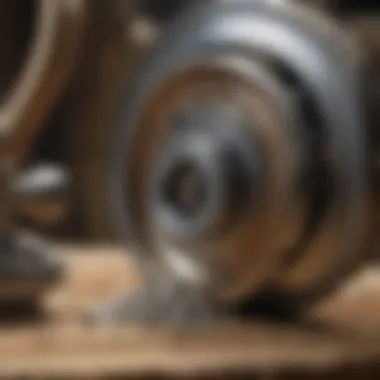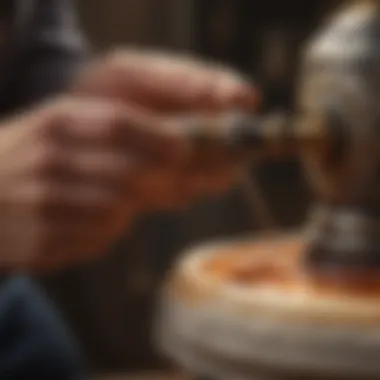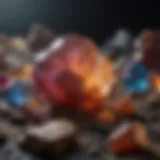Uncover the Intricacies of the Lapidary Grinder: A Detailed Exploration


Rock and Fossil Identification
Embarking on a journey into the captivating realm of lapidary grinders necessitates a fundamental grasp of rock and fossil identification. Before delving into the intricacies of grinding and polishing, it is essential to comprehend the varied types of rocks and fossils one may encounter in this pursuit. These geological treasures exhibit a diverse range of characteristics that discerning collectors must keenly observe – colors, patterns, textures, and structural composition are but a few aspects to consider. Equipping oneself with the essential tools for identification, such as magnifying glasses, scratch tests, and UV lights, proves invaluable in discerning the unique attributes of each specimen.
Collecting Tips and Techniques
Mastering the art of lapidary grinding extends beyond the confines of workshops; it commences with the adept selection and collection of rocks and fossils. Optimal success in this endeavor hinges on adhering to best practices for collecting, which entail environmental consciousness, ethical considerations, and meticulous record-keeping of specimen origins. Venturing into the field calls for adeptly locating prime collecting sites, where geological wonders await discovery. Safely extracting specimens, whether through hand tools or specialized equipment, demands finesse and caution to preserve their integrity for subsequent grinding and polishing processes.
Preservation and Display
Upon the successful acquisition of prized rocks and fossils, attention must be directed towards preserving their natural allure and showcasing them in all their glory. Various techniques, from stabilizing fragile formations to inhibiting decay, are employed to maintain the longevity of these geological treasures. Appropriate storage methods, such as climate-controlled cabinets or acid-free containers, are paramount in safeguarding specimens from environmental degradation. Moreover, creative display ideas – be it mounting specimens on stands, arranging them in thematic dioramas, or crafting bespoke exhibits – elevate the aesthetic appeal of collections, transforming them into captivating showcases of Earth's geological splendor.
Geological Insights
Diving deeper into the crux of lapidary pursuits unveils a complex tapestry of geological insights waiting to be unraveled. Exploring the geological formations and processes that have shaped rocks and fossils imparts invaluable knowledge about Earth's history and evolution. Discovering the historical significance of prominent specimens offers a glimpse into bygone eras and the organisms that once roamed ancient lands. Furthermore, delving into notable discoveries within the field of paleontology elucidates the groundbreaking contributions of researchers and collectors in expanding our understanding of the planet's geological heritage.
Introduction
Lapidary grinders are an indispensable tool for rock and fossil collectors, enabling them to transform rough stones and gems into exquisite pieces of art. This comprehensive guide delves deep into the intricacies of lapidary grinders, offering valuable insights for enthusiasts at all skill levels. From understanding the key components to mastering grinding techniques, this article is your gateway to unlocking the full potential of these remarkable machines.
Understanding Lapidary Grinders
Key Components of a Lapidary Grinder
Exploring the fundamental elements of a lapidary grinder reveals its inner complexity. The motor serves as the powerhouse, driving the grinding wheels to shape and polish stones with precision. The grinding discs, pivotal in the grinding process, come in various materials and grit sizes, each tailored to specific tasks. Additionally, the water reservoir plays a crucial role in cooling and lubricating the stones during grinding, ensuring optimal results. Understanding these components is essential for harnessing the full capabilities of a lapidary grinder.
Types of Lapidary Grinders
Diving into the realm of lapidary grinders unveils a diverse array of options, from arbors to flat lap machines, each catering to distinct grinding needs. The arbor grinder, suitable for beginners, offers versatility in shaping and polishing small stones. In contrast, flat lap machines excel in providing flat surfaces and precise edges to gemstones. Selecting the right type of grinder depends on the specific requirements of the task at hand, highlighting the importance of aligning grinder type with intended use.
Applications in Rock and Fossil Preparation
The applications of lapidary grinders extend beyond mere hobbyist pursuits, playing a vital role in the field of rock and fossil preparation. Whether it's shaping rough rocks into polished cabochons or preparing fossil specimens for display, these machines enhance precision and efficiency in geological endeavors. By integrating lapidary grinders into rock and fossil preparation processes, enthusiasts can elevate the quality of their work, emphasizing the indispensable nature of these tools.
Choosing the Right Grinder
Factors to Consider
Selecting the ideal lapidary grinder necessitates a thoughtful evaluation of various factors, including the type of materials to be worked on, the desired level of precision, and the available workspace. Understanding these factors helps in choosing a grinder that aligns with the specific needs and goals of the user, ensuring optimal performance and results. The right grinder not only enhances efficiency but also elevates the overall grind and polish quality, making it a crucial consideration in the purchase process.


Size and Power Specifications
Delving into size and power specifications sheds light on the capabilities of lapidary grinders, with larger machines offering increased work capacity and power for tackling larger stones. The choice between motor power and disc size rests on the scale of projects and the user's level of experience, influencing the efficiency and speed of the grinding process. Balancing size and power specifications with practical requirements is key to finding a grinder that meets the user's specific needs.
Quality of Grinding Discs
The quality of grinding discs directly impacts the finish and precision of the grinding process, with materials like diamond and silicon carbide offering superior durability and sharpness. Opting for high-quality grinding discs ensures consistent results and longevity, minimizing the need for frequent replacements. Evaluating the composition and grit size of grinding discs enables users to make informed decisions, emphasizing the crucial role of disc quality in achieving professional-level finishes.
Setting Up Your Workspace
In this article, the significance of setting up your workspace is paramount to ensure optimal functionality and safety when using a lapidary grinder. A well-organized workspace not only enhances efficiency but also promotes a conducive environment for honing your lapidary skills. The meticulous arrangement of tools and supplies, consideration of ventilation and safety measures, and optimization of lighting conditions all play crucial roles in creating a workspace that fosters productivity and creativity.
Creating an Efficient Work Area
Ventilation and Safety Measures:
Delving into ventilation and safety measures in the setup of your workspace is crucial for maintaining a clean and hazard-free environment. Adequate ventilation helps in dissipating harmful dust particles created during the grinding process, ensuring a healthy work atmosphere. Implementing safety measures such as wearing protective gear and positioning equipment rightly minimizes the risk of accidents and ensures smoother operations. The incorporation of ventilation systems, such as fans or air purifiers, and adherence to safety protocols are essential practices that contribute to a safe and productive workspace.
Organizing Tools and Supplies:
Organizing tools and supplies in your workspace is a fundamental aspect that enhances efficiency and streamlines workflow. Proper organization not only saves time by allowing easy access to necessary tools but also reduces the chances of misplaced equipment. Categorizing tools based on their usage and ensuring a designated place for each item promotes a clutter-free environment, facilitating a focused and structured approach to lapidary work. By maintaining an organized workspace, you create a conducive setting for seamless and uninterrupted grinding and polishing sessions.
Optimizing Lighting Conditions:
Optimizing lighting conditions in your workspace is vital for precision and accuracy in lapidary work. Adequate lighting not only aids in observing intricate details of the materials being worked on but also reduces eye strain and enhances overall visibility. Natural light or adjustable, bright artificial lighting can be strategically positioned to eliminate shadows and illuminate the work area effectively. By optimizing lighting conditions, you ensure that every step of the grinding and polishing process is executed with meticulous care and attention to detail.
Proper Equipment Maintenance
Maintaining lapidary equipment is a critical aspect that prolongs the lifespan of your tools and ensures consistent performance. Regular cleaning and lubrication of the grinder components prevent the buildup of debris and ensure smooth operation. Inspecting the equipment for wear and tear allows timely replacements of damaged parts, safeguarding against potential breakdowns during work. Ensuring calibration and alignment of the grinder components maintains precision in grinding results and prevents inaccuracies. By adhering to proper equipment maintenance practices, you guarantee the longevity and effectiveness of your lapidary grinder, enabling continuous and uninterrupted rock and fossil preparation activities.
Mastering Grinding Techniques
In the realm of lapidary grinders, mastering grinding techniques holds paramount importance. Being able to effectively grind and polish stones and fossils is the essence of this craft. Understanding the nuances of various grit sizes, employing proper shaping and smoothing techniques, and avoiding common mistakes are the pillars of achieving exceptional results in lapidary work.
Grinding Basics
Understanding Grit Sizes
Understanding grit sizes is crucial in lapidary work as it determines the coarseness or fineness of the abrasive particles used in the grinding process. Finer grit sizes result in smoother finishes, while coarser grit sizes are adept at shaping rough surfaces. The selection of the appropriate grit size depends on the desired outcome, whether it be precision shaping or smooth polishing.


Techniques for Shaping and Smoothing
Techniques for shaping and smoothing play a vital role in the final appearance of lapidary creations. Skilled artisans employ various techniques, such as grinding, cabbing, and faceting, to sculpt stones into desired shapes. Smoothing techniques like tumbling and polishing enhance the luster and refine the surface texture of the stones, providing a professional finish.
Avoiding Common Mistakes
To excel in lapidary grinding, it is essential to steer clear of common errors that can compromise the quality of the final product. Mistakes like applying excessive pressure, improper tool usage, or neglecting safety protocols can result in damage to the stones or equipment. Adhering to proper grinding practices and learning from mistakes is key to honing one's skills in lapidary work.
Advanced Polishing Strategies
Choosing the Right Polishing Compounds
Selecting the right polishing compound is a critical decision in achieving a mirror-like finish on stones and fossils. Different compounds offer varying degrees of abrasiveness and are tailored for specific materials. Choosing the appropriate compound based on the hardness of the stone and desired shine level is essential for a successful polishing process.
Achieving Mirror-Like Finishes
Achieving mirror-like finishes requires precision and expertise in the polishing stage of lapidary work. By meticulously buffing the surface with the correct polishing techniques and compounds, artisans can bring out the natural beauty of the stones, creating a flawless reflective surface that enhances the overall aesthetic appeal.
Tips for Enhancing Luster
Enhancing the luster of gemstones and minerals is a sign of a seasoned lapidary artist. By implementing strategic finishing touches, such as adjusting the polishing speed and pressure, using fining agents, and employing specialized tools, artisans can elevate the brilliance and clarity of the stones, resulting in stunning and lustrous lapidary creations.
Troubleshooting and Maintenance
In the world of lapidary grinders, Troubleshooting and Maintenance stand out as pivotal aspects essential for ensuring the smooth operation and longevity of these intricate tools. By focusing on Troubleshooting and Maintenance, enthusiasts can address issues promptly and keep their equipment in optimal condition, thus maximizing performance and efficiency. It is imperative to pay close attention to every detail concerning Troubleshooting and Maintenance to avoid any setbacks or damage to the equipment.
Common Issues and Solutions
Uneven Grinding Patterns:
The occurrence of Uneven Grinding Patterns can significantly impact the quality and precision of the grinding process, leading to subpar results in rock and fossil preparation. Identifying and rectifying these patterns is crucial for achieving uniformity and consistency in the final output of lapidary work. This issue often stems from irregularities in the grinding disc or improper alignment of the equipment. By understanding the causes behind Uneven Grinding Patterns, enthusiasts can take proactive measures to enhance the effectiveness of their grinding techniques.
Overheating of Equipment:
Overheating of Equipment poses a serious threat to the functionality and durability of lapidary grinders. Excessive heat buildup can negatively affect the motor, bearings, and grinding discs, potentially causing irreversible damage if not addressed promptly. Maintaining optimal operating temperatures is essential for ensuring smooth operation and preventing overheating-related malfunctions. By implementing proper cooling mechanisms and periodically monitoring equipment temperature, enthusiasts can safeguard their investment and prolong the lifespan of their lapidary grinders.
Chipped or Damaged Discs:
The presence of Chipped or Damaged Discs can undermine the integrity and efficacy of the grinding process, leading to substandard results and unnecessary wear on the equipment. It is crucial to address any instances of chipping or damage to the grinding discs promptly to prevent further deterioration and maintain consistent grinding performance. Proper care and handling of grinding discs, such as avoiding impacts and abrasives, play a critical role in minimizing the risk of disc damage and ensuring optimal grinding outcomes.


Regular Maintenance Practices
Replacing Grinding Discs:
Regularly replacing Grinding Discs is paramount for sustaining the effectiveness and precision of lapidary grinding operations. Worn-out or damaged discs can impede the grinding process, resulting in inferior finishes and potential safety hazards. By adhering to a scheduled disc replacement regimen and selecting high-quality replacement discs, enthusiasts can uphold the performance standards of their lapidary grinders and achieve superior grinding results consistently.
Adjusting Tension and Pressure:
Fine-tuning the Tension and Pressure settings of a lapidary grinder is a critical aspect of equipment maintenance that directly impacts grinding performance and efficiency. Incorrect tension and pressure levels can lead to uneven grinding, overheating, or premature wear of components. By calibrating the tension and pressure according to manufacturer guidelines and monitoring these settings during operation, enthusiasts can optimize grinding outcomes, prolong equipment lifespan, and ensure a smooth grinding experience.
Ensuring Motor and Bearings Functionality:
The dependable operation of the Motor and Bearings is vital for the overall performance and longevity of a lapidary grinder. Regularly inspecting these components for signs of wear, lubricating moving parts, and ensuring proper alignment are essential maintenance practices that can prevent unexpected breakdowns and maintain optimal grinder functionality. By prioritizing the upkeep of the motor and bearings, enthusiasts can preemptively address potential issues, uphold operational efficiency, and extend the lifespan of their equipment.
Exploring Creative Applications
In the expansive world of lapidary grinding, the section on Exploring Creative Applications holds substantial importance. It serves as a gateway to artistic innovation and experimentation within the realm of rock and fossil collecting. By delving into creative applications, enthusiasts can elevate their craft beyond traditional methods, unlocking new possibilities for expression and design. This segment embodies the essence of ingenuity and creativity, offering rock and fossil collectors a platform to explore unconventional approaches and push the boundaries of their artistic boundaries.
Artistic Endeavors with Lapidary Grinders
Creating Custom Cabochons
Embarking on the journey of Creating Custom Cabochons opens pathways to personalized and unique creations in lapidary artistry. This specialized process involves shaping and polishing semi-precious stones to create distinctively designed cabochons, which are a popular choice among lapidary enthusiasts for their individuality and bespoke nature. The allure of Creating Custom Cabochons lies in the ability to customize each piece according to one's artistic vision, resulting in exclusive and one-of-a-kind designs that reflect the artist's creativity and skill. While this approach offers unparalleled creative freedom, it also requires precision and attention to detail to achieve the desired results.
Designing Unique Jewelry Pieces
Designing Unique Jewelry Pieces with lapidary grinders presents a means to transform raw materials into stunning wearable art. This aspect of lapidary work focuses on crafting bespoke jewelry items using polished stones created through the grinding and shaping process. One of the standout features of Designing Unique Jewelry Pieces is the ability to infuse individuality and character into each creation, distinguishing them from mass-produced jewelry. By incorporating custom-cut stones into their designs, artisans can showcase their craftsmanship and creativity, offering jewelry enthusiasts a distinctive alternative to mainstream accessories.
Innovative Sculpting Projects
Engaging in Innovative Sculpting Projects with lapidary grinders widens the scope of lapidary art beyond traditional forms, encouraging artists to explore unconventional sculpting techniques and design concepts. This facet of lapidary work entails sculpting rocks and minerals into intricate shapes and forms, pushing the boundaries of conventional lapidary artistry. The distinctive feature of Innovative Sculpting Projects lies in the freedom to experiment with different textures and structures, allowing artists to create avant-garde sculptural pieces that challenge aesthetic norms and inspire creativity. While innovative sculpting projects offer boundless creative opportunities, they also demand patience, skill, and an eye for detail to translate artistic visions into tangible masterpieces.
Collaborative Projects and Workshops
Community Engagement Opportunities
Participating in Community Engagement Opportunities within the lapidary community fosters connections, knowledge sharing, and collaborative learning experiences. These opportunities offer enthusiasts a platform to interact with like-minded individuals, exchange ideas, and collectively explore the diverse facets of lapidary artistry. The key characteristic of Community Engagement Opportunities lies in their ability to cultivate a sense of community and camaraderie among rock and fossil collectors, providing a supportive environment for skill development and creative exploration. By engaging in community projects and workshops, enthusiasts can broaden their perspectives, hone their techniques, and draw inspiration from the collective wisdom of experienced artisans within the lapidary community.
Learning from Experienced Artisans
Learning from Experienced Artisans stands as a valuable facet of skill enhancement and knowledge acquisition in the realm of lapidary arts. This aspect emphasizes the significance of mentorship, apprenticeship, and hands-on learning from seasoned professionals in the field. The key characteristic of Learning from Experienced Artisans lies in the opportunity to glean insights, tips, and techniques from seasoned practitioners, accelerating one's learning curve and refining their craftsmanship. By observing and interacting with experienced artisans, enthusiasts can gain practical wisdom, refine their techniques, and cultivate a deeper understanding of the intricacies of lapidary work.
Sharing Techniques and Inspirations
Sharing Techniques and Inspirations serves as a conduit for knowledge dissemination, creative exchange, and collective evolution within the lapidary community. This component revolves around the reciprocal sharing of skills, ideas, and inspiration among enthusiasts, fostering a culture of collaboration and continuous learning. The unique feature of Sharing Techniques and Inspirations lies in its ability to catalyze creative growth, spark innovative approaches, and foster a sense of solidarity among artists and artisans. By sharing their expertise and experiences, individuals can contribute to the enrichment of the lapidary community, inspiring others to push their creative boundaries and expand their horizons in the world of lapidary arts.







